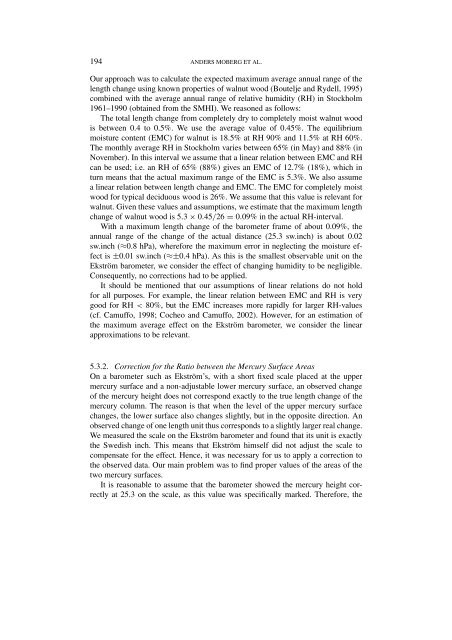DAILY AIR TEMPERATURE AND PRESSURE SERIES ... - BALTEX
DAILY AIR TEMPERATURE AND PRESSURE SERIES ... - BALTEX
DAILY AIR TEMPERATURE AND PRESSURE SERIES ... - BALTEX
You also want an ePaper? Increase the reach of your titles
YUMPU automatically turns print PDFs into web optimized ePapers that Google loves.
194 <strong>AND</strong>ERS MOBERG ET AL.<br />
Our approach was to calculate the expected maximum average annual range of the<br />
length change using known properties of walnut wood (Boutelje and Rydell, 1995)<br />
combined with the average annual range of relative humidity (RH) in Stockholm<br />
1961–1990 (obtained from the SMHI). We reasoned as follows:<br />
The total length change from completely dry to completely moist walnut wood<br />
is between 0.4 to 0.5%. We use the average value of 0.45%. The equilibrium<br />
moisture content (EMC) for walnut is 18.5% at RH 90% and 11.5% at RH 60%.<br />
The monthly average RH in Stockholm varies between 65% (in May) and 88% (in<br />
November). In this interval we assume that a linear relation between EMC and RH<br />
can be used; i.e. an RH of 65% (88%) gives an EMC of 12.7% (18%), which in<br />
turn means that the actual maximum range of the EMC is 5.3%. We also assume<br />
a linear relation between length change and EMC. The EMC for completely moist<br />
wood for typical deciduous wood is 26%. We assume that this value is relevant for<br />
walnut. Given these values and assumptions, we estimate that the maximum length<br />
change of walnut wood is 5.3 × 0.45/26 = 0.09% in the actual RH-interval.<br />
With a maximum length change of the barometer frame of about 0.09%, the<br />
annual range of the change of the actual distance (25.3 sw.inch) is about 0.02<br />
sw.inch (≈0.8 hPa), wherefore the maximum error in neglecting the moisture effect<br />
is ±0.01 sw.inch (≈±0.4 hPa). As this is the smallest observable unit on the<br />
Ekström barometer, we consider the effect of changing humidity to be negligible.<br />
Consequently, no corrections had to be applied.<br />
It should be mentioned that our assumptions of linear relations do not hold<br />
for all purposes. For example, the linear relation between EMC and RH is very<br />
good for RH < 80%, but the EMC increases more rapidly for larger RH-values<br />
(cf. Camuffo, 1998; Cocheo and Camuffo, 2002). However, for an estimation of<br />
the maximum average effect on the Ekström barometer, we consider the linear<br />
approximations to be relevant.<br />
5.3.2. Correction for the Ratio between the Mercury Surface Areas<br />
On a barometer such as Ekström’s, with a short fixed scale placed at the upper<br />
mercury surface and a non-adjustable lower mercury surface, an observed change<br />
of the mercury height does not correspond exactly to the true length change of the<br />
mercury column. The reason is that when the level of the upper mercury surface<br />
changes, the lower surface also changes slightly, but in the opposite direction. An<br />
observed change of one length unit thus corresponds to a slightly larger real change.<br />
We measured the scale on the Ekström barometer and found that its unit is exactly<br />
the Swedish inch. This means that Ekström himself did not adjust the scale to<br />
compensate for the effect. Hence, it was necessary for us to apply a correction to<br />
the observed data. Our main problem was to find proper values of the areas of the<br />
two mercury surfaces.<br />
It is reasonable to assume that the barometer showed the mercury height correctly<br />
at 25.3 on the scale, as this value was specifically marked. Therefore, the













